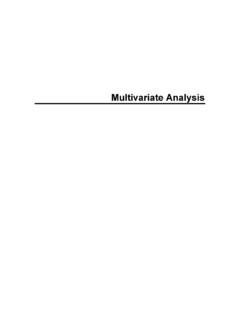Transcription of SIMULTANEOUS DIAGONALIZATION OF …
1 SIMULTANEOUS DIAGONALIZATION OF hermitian . matrices . Link to: physicspages home page. To leave a comment or report an error, please use the auxiliary blog. References: Shankar, R. (1994), Principles of Quantum Mechanics, Plenum Press. Exercise The spectral theorem guarantees that any normal operator can be unitar- ily diagonalized. For commuting hermitian operators we can go one step further and show that a set of such operators can be simultaneously diago- nalized with a single unitary transformation. The proof is a bit lengthy and is spelled out in full both in Zwiebach's notes (chapter 6) and in Shankar's book (chapter 1, theorem 13) so I won't reproduce it in full here. To sum- marize the main points: We can start by considering two operators and and assume that at least one of them, say , is nondegenerate, that is, for each eigenvalue there is only one eigenvector (up to multiplication by a scalar). Then for one eigenvalue i of we have | i i = i | i i (1). We also have | i i = i | i i (2).
2 So that, provided [ , ] = 0, | i i is also an eigenvector of for eigen- value i . However, since is nondegenerate, | i i must be a multiple of | i i so that, we have | i i = i | i i (3). so that | i i is an eigenvector of for eigenvalue i . Therefore a unitary transformation that diagonalizes will also diagonalize . Note that in this case we didn't need to assume that is nondegenerate. If both and are degenerate, things are a bit more complicated, but the basic idea is this. Suppose we find a basis that diagonalizes and arrange the basis vectors within the unitary matrix U in an order that groups all equal eigenvalues together, so that all the eigenvectors corresponding to eigenvalue 1 occur first, followed by all the eigenvectors corresponding to eigenvalue 2 and so on, up to eigenvalue m where m < n is the number 1. SIMULTANEOUS DIAGONALIZATION OF hermitian matrices 2. of distinct eigenvalues (which is less than the dimension n of the matrix . because is degenerate).
3 Each subset of eigenvectors corresponding to a single eigenvalue forms a subspace, and we can show that the other matrix , operating on a vec- tor from that subspace transforms the vector to another vector that also lies within the same subspace. Now, any linearly independent selection of ba- sis vectors within the subspace will still diagonalize for that eigenvalue , so we can select such a set of basis vectors within that subspace that also diagonalizes within that subspace. The process can be repeated for each eigenvalue of resulting in a set of basis vectors that diagonalizes both matrices . Obviously, I've left out the technical details of just how this is done, but you can refer to either Zwiebach's notes or Shankar's book for the details. As an example, consider the two matrices . 1 0 1. = 0 0 0 (4). 1 0 1.. 2 1 1. = 1 0 1 (5). 1 1 2. We can verify that they commute: . 3 0 3. = = 0 0 0 (6). 3 0 3. We can find the eigenvalues and eigenvectors of and in the usual way.
4 For we have det ( I) = 0 (7). (1 ) [( (1 ))] + = 0 (8). 2 2 = 0.. (9). = 0, 0, 2 (10). Solving the eigenvector equation, we get, for = 0. SIMULTANEOUS DIAGONALIZATION OF hermitian matrices 3.. a 0. ( I) b = 0 . (11). c 0.. 1 0 1 a 0. 0 0 0 b = 0 (12). 1 0 1 c 0. a = c (13). b = anything (14). Thus 2 orthonormal eigenvectors are . 1. 1. |01 i = 0 (15). 2 1.. 0. |02 i = 1 . (16). 0. For = 2: . 1 0 1 a 0. 0 2 0 b = 0 (17). 1 0 1 c 0. a=c (18). b=0 (19).. 1. 1. |2i = 0 (20). 2 1. For , we can go through the same procedure to find det ( I) = 0 (21). (2 )2 + 2 + 2 2 + = 0 (22). ( 2) [ (2 ) + 3] = 0 (23). = 1, 2, 3 (24). We could calculate the eigenvectors from scratch, but from the simulta- neous DIAGONALIZATION theorem, we know that the eigenvector |2i from . must be an eigenvector of , and we find by direct calculation that SIMULTANEOUS DIAGONALIZATION OF hermitian matrices 4. |2i = 3 |2i (25). so |2i is the eigenvector for = 3. For the other two eigenvalues of , we know the eigenvectors must be linear combinations of |01 i and |02 i from.
5 Such a combination must have form . a a |01 i + b |02 i = b (26). a so we must have . a a+b a b = 2a = b (27). a a b a for = 1, 2. For = 2, we have a=b (28).. 1. 1. | = 2i = 1 (29). 3 1. For = 1: b = 2a (30).. 1. 1. | = 1i = 2 (31). 6 1. The columns of the unitary transformation matrix are therefore given by 29, 31 and 20, so we have 1 1 1.. 3 6 2. U = . 1 2 0 . (32). 3 6 . 13 16 12. 1 1 13.. 3 3. U = . 1 26 16 . (33). 6 . 1 0 1. 2 2. SIMULTANEOUS DIAGONALIZATION OF hermitian matrices 5. By matrix multiplication, we can verify that this transformation diago- nalizes both and : . 0 0 0. U U = 0 0 0 (34). 0 0 2.. 2 0 0. U U = 0 1 0 (35). 0 0 3. P INGBACKS. Pingback: Coupled masses on springs - properties of the propagator Pingback: Adding two spin-1/2 systems - product and total-s bases Pingback: Nonrelativistic field theory - number, creation and annihilation operators





